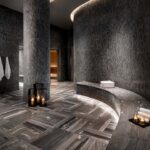Welcome to the second iteration of Vogue’s global spa guide, an index of the 100 best spas in the world, built from the expertise of our global editors and trusted contributors. There is a lot to choose from in the world of wellness, and no matter how far you’re planning to travel—from a subway ride to a trans-Atlantic flight—we want to make sure it’s worth the journey. Whatever your path, let us be your guide.
Why go here?
The experience of staying at Six Senses Vana—and it really is, as any visitor will quickly discover, an experience—begins well before you actually arrive. There’s the information you’ll be asked for in the weeks ahead of your stay so that the team can begin preparing your custom health and wellness plan, whether for the minimum break of five days, or in the case of the lucky few who can afford it, a month and upwards. It takes a lengthy pilgrimage to get there, after all, which will most likely see you land at Delhi Airport before being collected in one of the resort’s plush minivans to navigate the city’s infamously traffic-clogged streets. A few hours later, you’ll pass through the teeming city of Dehradun. On its outskirts, you’ll begin the slow climb up winding roads to the foothills of the Himalayas before pulling down a discrete side road and plunging deep into a forest of towering sal trees.
As soon as you step through the doors of the arrival pavilion, you know you’ve crossed a threshold of some kind. My “guest experience manager” for the week floated in with a detox tea and provided me with a set of thick linen kurta pajamas to change into before I received a red string to tie around my wrist as a blessing and had a dot of vermillion powder swiftly applied to my forehead. Next I was whisked away in a golf cart along the leafy pathways that snake around the 21-acre property.
Photo: Courtesy of Six Senses Vana
What’s the vibe?
Six Senses Vana is—in all manners—a retreat, and it has taken steps to preserve a sense of tranquility and seclusion. Phones and digital devices are banned in public areas, and while beer and wine are available upon request at mealtimes, it’s unlikely you’ll find yourself tempted. The decor is tastefully neutral with lots of hanging sculptures, and the overall feeling is serene. From the first night onward, I felt I was resting more deeply and restoratively than ever before—even when I was awoken in the morning by a clattering of branches, eventually revealed to be a particularly lively monkey performing some Cirque du Soleil–worthy maneuvers through the canopies above.
Photo: Courtesy of Six Senses Vana
What’s the history?
First opened as simply Vana in 2014 by Veer Singh, the resort quickly built a reputation as one of the most restorative (and ravishingly beautiful) destinations in the world, both for the subdued luxury of its design and the sheer breadth of wellness traditions on offer. It’s one of the few places globally, for example, to offer the Tibetan medicine practice of Sowa Rigpa, here delivered by therapists who trained at the Dalai Lama’s Tibetan Medical and Astro Institute. The Dalai Lama himself paid a visit to the resort back in 2016. In 2022, the property was acquired by Six Senses, the hotel brand that has established itself as a pioneer in delivering an accomplished blend of luxury, sustainability, and wellness. Naturally, there was some skepticism from longtime Vana devotees (or Vanavasis, as they’re nicknamed). But most of those have proven unfounded. The majority of the team has remained from its previous iteration, and the only real tweaks to its well-honed formula are the additions of a few signature Six Senses touches (a more high-tech wellness screening upon arrival, for example).
Photo: Courtesy of Six Senses Vana
What should you try?
The treatments at Six Senses Vana are not only world-class, but they also set the very standard of world-class. The head-spinning array of activities on offer each day include breath work, meditation sessions, and—a particular favorite—raga therapy, which essentially involves lying on the ground as a sitar is gently strummed. There are excursions offered at an additional cost, like an arti ceremony held on the river in nearby Rishikesh, or hikes to nearby monasteries and nature reserves. Among the other offerings I experienced was the Ku Nye Tibetan oil massage to soothe my weary limbs after the long flight over and an array of treatments at the outbuilding, dedicated solely to Ayurvedic principles, at which I was slathered in warm oil and applied with hot herbal poultices. On the afternoon before I left, I experienced a sound healing and a Hor Gyi Metsa session that incorporated Tibetan chanting, preparing me to ease back into the outside world.
Read the full article here




